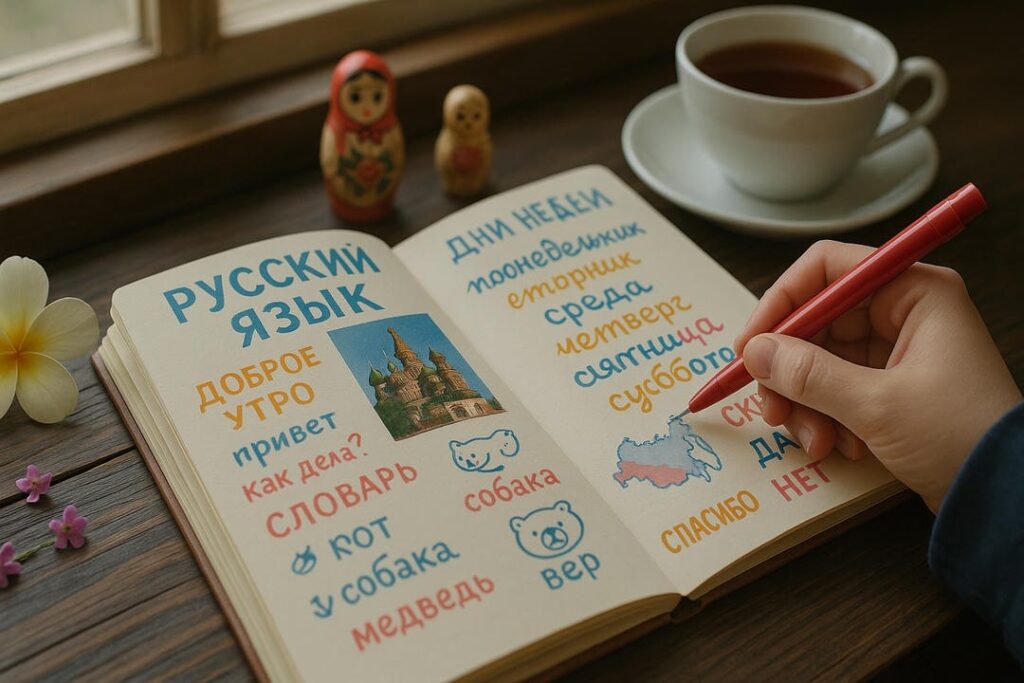The use of diminutive forms in Russian is a nuanced aspect of the language that reflects emotional connections and social dynamics. These forms, created through specific suffixes, can enhance communication by expressing affection and familiarity. However, their appropriateness varies notably depending on the context. Understanding when and how to employ these diminutives is essential for effective interaction. This raises important questions about their role in both casual and formal settings.
Table of Contents
ToggleWhat Are Diminutive Forms in Russian?

Diminutive forms in Russian play an important role in everyday communication by adding layers of meaning related to affection, familiarity, and sometimes smallness. Unlike in some languages where diminutives mainly indicate size, Russian diminutives often reflect the speaker’s emotional attitude toward the person or object being described. This linguistic feature allows speakers to express warmth, tenderness, or closeness, making conversations feel more personal and emotionally nuanced.
The process of forming diminutives typically involves adding specific suffixes to the root of a noun. Common suffixes like “-ик,” “-очка,” and “-енька” modify the original word to create new forms that carry these affectionate or familiar connotations. For example, a simple noun like “дом” (house) can become “домик,” which suggests a small or cozy house. Similarly, personal names often receive diminutive endings to express fondness or intimacy, which is deeply embedded in social interactions and relationships.
Beyond mere grammatical function, diminutive forms in Russian reflect cultural attitudes and social customs. They are used not only among family and close friends but also in polite or respectful contexts to soften requests or statements. This linguistic trait reveals how language mirrors social norms, emphasizing emotional connection and interpersonal dynamics. Overall, diminutive forms enrich the Russian language by providing speakers with subtle ways to convey their feelings and social intentions without explicitly stating them.
The Importance of Diminutive Forms in Communication
Diminutive forms in the Russian language are much more than simple alterations of words; they are a fundamental element of communication that conveys subtle social cues and emotional layers. These forms, often created by adding suffixes like -ик (-ik), -очка (-ochka), or -енька (-enka), serve as powerful tools to express attitudes, feelings, and relationships between speakers. Understanding their use is essential for grasping the cultural and emotional fabric of Russian interactions.
Culturally, diminutives reflect a wide spectrum of sentiments. For example, they can indicate warmth and affection when speaking to loved ones, such as family members or close friends. At the same time, diminutives can subtly convey condescension or irony depending on tone and context, making them versatile and nuanced in everyday speech. This duality makes diminutives a key to interpreting the speaker’s intent beyond the literal meaning of the words.
In terms of emotional expression, diminutives soften statements, making them more personal and intimate. They are frequently used to comfort or endear, turning otherwise neutral or harsh expressions into gentle, caring messages. This use is prevalent in various social contexts—from addressing children and pets to romantic partners and close colleagues.
Some common diminutive forms and their typical emotional contexts include:
- Котик (kotik) — often used when talking to or about a pet cat, symbolizing affection and tenderness.
- Малыш (malysh) — a tender way to address a child or a loved one, conveying protection and warmth.
- Дорогой (dorogoy) — literally meaning “dear,” used with partners or close friends to express intimacy and love.
- Солнышко (solnyshko) — literally “little sun,” a term of endearment often used for children or beloved people to show warmth and brightness.
- Зайчик (zaychik) — meaning “little hare,” another affectionate form used for children or loved ones to express fondness.
Besides these examples, diminutives also appear frequently in everyday expressions to create a softer tone, such as:
- Пишу тебе письмецо (Pishu tebe pis’metso) — “I am writing you a little letter,” where “письмецо” is the diminutive form of “письмо” (letter), adding a casual, intimate feel.
- Давай поиграем в игрушечки (Davai poigraem v igrushechki) — “Let’s play with little toys,” using the diminutive “игрушечки” to evoke playfulness and affection.
In summary, diminutive forms in Russian are indispensable in shaping the emotional tone and social dynamics of communication. They provide speakers with a rich palette of subtle meanings that enrich conversations, allowing for expressions of kindness, intimacy, humor, and sometimes irony or sarcasm. Mastery of these forms enhances understanding of both language and culture, revealing the delicate balance of respect, affection, and social hierarchy embedded in Russian speech.
Basic Rules for Forming Diminutives in Russian
In Russian, forming diminutive forms follows clear patterns based on the sound and structure of the original noun. These diminutives are created by adding specific suffixes, which change depending on the gender of the noun and sometimes its ending. These suffixes not only soften the meaning of the word but also add emotional warmth, familiarity, or affection.
Gender and Suffix Patterns
- Masculine nouns often use suffixes like -ик (-ik) or -ок (-ok).
For example:- стол (stol) meaning “table” becomes столик (stolik) meaning “little table.”
- дом (dom) meaning “house” can become домик (domik), meaning “little house” or “cottage.”
- Feminine nouns typically take suffixes such as -ка (-ka) or -очка (-ochka).
For example:- книга (kniga) meaning “book” becomes книжка (knizhka), a more affectionate or informal way to say “book.”
- дочка (dochka) is a diminutive form of дочь (doch’), meaning “daughter,” with a strong tone of endearment.
- Neuter nouns also have diminutives, often using suffixes like -ко (-ko) or sometimes -це (-tse).
For example:- окно (okno) meaning “window” becomes оконце (okon’tse), meaning a small or cozy window.
Additional Notes on Diminutive Formation
- The choice of suffix can depend on the final sounds of the noun and the rhythm of the resulting word.
- Some nouns have multiple diminutive forms with slightly different emotional overtones. For example, кот (kot, “cat”) can become котик (kotik), which is affectionate and tender, or котёнок (kotyonok), which means “kitten” and also has a cute, endearing quality.
- Diminutives may also be combined with affectionate prefixes or used repeatedly to intensify the feeling. For example, маленький (malen’kiy), meaning “small,” is sometimes combined with diminutives to emphasize size and tenderness.
Understanding how to form diminutives correctly helps learners of Russian express subtle emotions such as affection, intimacy, or tenderness. These forms are deeply ingrained in Russian culture and everyday speech, making them essential for natural and meaningful communication. By mastering these patterns, speakers can better navigate social situations where tone and emotional nuance are important.
Key Russian Words Related to Diminutive Formation
- Суффикс (suffix) – A letter or group of letters added to a word to change its meaning or form.
- Мужской род (muzhskoy rod) – Masculine gender.
- Женский род (zhenskiy rod) – Feminine gender.
- Средний род (sredniy rod) – Neuter gender.
- Ласкательный суффикс (laskatel’nyy suffiks) – Diminutive suffix, literally “affectionate suffix.”
Mastering these basics gives learners a solid foundation for using diminutives naturally and appropriately in various contexts.
Common Diminutive Suffixes
In Russian, diminutives are an important part of the language. They are used to show affection, smallness, or familiarity. Understanding diminutive suffixes helps learners recognize the emotional tone behind words and communicate more naturally.
Diminutives are created by adding special endings (suffixes) to a base noun. These suffixes change the meaning of the word to express that something is smaller, cuter, or dear to the speaker.
Here are some common diminutive suffixes and how they work:
| Base Word (Cyrillic) | Base Word (English phonetic) | Meaning of Base Word | Diminutive Suffix | Diminutive Form (Cyrillic) | Phonetic Pronunciation | Meaning of Diminutive |
|---|---|---|---|---|---|---|
| кот | kot | cat | -ик | котик | [ˈko.tʲɪk] | little cat / dear cat |
| дом | dom | house | -ик | домик | [ˈdo.mʲɪk] | little house |
| книга | kniga | book | -очка | книжечка | [ˈknʲi.ʐɨt͡ɕ.kə] | little book |
| мама | mama | mom | -очка / -уля | мамочка | [ˈma.mə.t͡ɕkə] | dear mom |
| девочка | devochka | girl | -ка | девочка (already dimin.) | [ˈdʲe.və.t͡ɕkə] | little girl |
| ручка | ruchka | pen / handle | -ка | ручка (already dimin.) | [ˈrut͡ɕ.kə] | little pen / handle |
| друг | drug | friend | -ок | дружок | [ˈdru.ʐok] | little friend / buddy |
| сын | syn | son | -ок | сынок | [sɨˈnok] | dear son |
Explanation of Suffixes
- -ик (-ik): This is one of the most common diminutive suffixes. It often adds the meaning “little” or “cute” to masculine nouns.
Example: кот (kot) → котик (kotik) = little cat. - -очка (-ochka): This suffix is usually added to feminine nouns and also expresses smallness or affection.
Example: книга (kniga) → книжечка (knizhechka) = little book. - -уля (-ulya): This suffix adds a tender or affectionate tone and is often used with family and close people.
Example: мама (mama) → мамуля (mamulya) = dear mom (more affectionate than мама). - -ок (-ok): Used mostly with masculine nouns, it conveys closeness or endearment.
Example: друг (drug) → дружок (druzhok) = little friend or buddy. - -ка (-ka): Sometimes used as a diminutive, especially for feminine nouns or objects; often the noun already has this suffix and is considered a diminutive form itself.
Example: девочка (devochka) = little girl.
Diminutives are everywhere in Russian speech—used by adults and children alike. They help soften statements, make conversations warmer, and show emotional connection. For example, calling someone “мамочка” instead of “мама” shows a deeper affection and closeness.
Using diminutives correctly can make your Russian sound more natural and friendly. It also helps you understand native speakers better when they use these forms to express feelings or describe something smaller or cuter.
Additional Related Russian Terms with Diminutives
| Russian Word (Cyrillic) | Phonetic Pronunciation | English Meaning |
|---|---|---|
| бабушка | [ˈbabʊʂkə] | grandmother |
| бабулечка | [bəˈbu.lʲet͡ɕ.kə] | dear grandma |
| сестра | [sʲɪsˈtra] | sister |
| сестричка | [sʲɪsˈtrʲit͡ɕ.kə] | little sister |
| брат | [brat] | brother |
| братик | [ˈbratʲɪk] | dear/little brother |
| собака | [sɐˈbakə] | dog |
| собачка | [sɐˈbat͡ʃkə] | little dog |
| окно | [ɐkˈno] | window |
| окошко | [ɐˈkoʂkə] | little window |
Understanding and practicing these diminutive forms will help you speak Russian more warmly and understand the cultural context behind everyday conversations.
Diminutives for Names in Russian: How to Create Affectionate Variants
In Russian, diminutives are not just used with common nouns; they play a vital role in personal names as well. Creating affectionate variants of names is a deeply ingrained part of Russian culture and communication. These forms allow speakers to express warmth, closeness, and familiarity, making social interactions more personal and emotionally rich.
How Diminutives for Names Are Formed
Russian diminutives for names are often made by adding specific suffixes or altering the original name slightly. Common suffixes include -ка (-ka), -чик (-chik), -очка (-ochka), and -енька (-enka). These suffixes add a sense of tenderness or affection. Sometimes, the root of the name is also shortened or changed to sound softer or cuter.
For example:
- Анна (Anna) becomes Аня (Anya) or even Анечка (Anechka)
- Михаил (Mikhail) becomes Миша (Misha) or Мишенька (Mishenka)
- Екатерина (Ekaterina) becomes Катя (Katya) or Катюша (Katyusha)
These forms are not random but follow patterns that native speakers learn naturally. The choice of diminutive form can depend on the relationship between people, the situation, or the speaker’s intention to show affection, endearment, or sometimes playful teasing.
Cultural Significance
In Russian culture, using diminutives with names is a way to show emotional closeness and trust. Family members, close friends, and lovers often use these affectionate forms. For example, parents typically use diminutives when speaking to their children to express love and care. Among friends, it can signal camaraderie and warmth.
Additionally, diminutive forms can soften the tone of a request or command. Instead of sounding harsh or demanding, using a diminutive makes the phrase sound gentler and kinder. For example:
- Instead of saying “Иди сюда” (Idi syuda) – “Come here,” a parent might say “Иди сюда, Мишенька” (Idi syuda, Mishenka), which feels more affectionate.
Emotional Nuance in Language
The use of diminutives highlights the emotional nuance embedded in the Russian language. It’s not just about the words themselves but how they reflect relationships and feelings. Understanding these forms helps learners grasp the subtle dynamics of Russian social interactions.
Keywords in Russian with English Explanations
- Уменьшительно-ласкательные имена (Umenshitel’no-laskatel’nye imena) — diminutive and affectionate names
- Суффикс (-ka, -chik, -ochka) — suffix (like -ka, -chik, -ochka)
- Обращение (Obrashchenie) — form of address
- Ласковое имя (Laskovoye imya) — affectionate name
- Теплота в общении (Teplota v obshchenii) — warmth in communication
- Близкие отношения (Blizkiye otnosheniya) — close relationships
Additional Notes
- Diminutives can have many layers; for example, Катя is affectionate but neutral, while Катюша adds more warmth or even playful emotion.
- Sometimes diminutives become independent names in everyday speech or literature.
- Overusing diminutives with strangers can be considered too informal or intrusive, so they are mostly reserved for familiar people.
Recognizing and using these diminutive forms appropriately will greatly improve understanding and communication in Russian social settings. They reveal much about how Russians express care and build connections through language.
Using Diminutives for Nouns and Adjectives

In Russian, diminutives play a significant role in everyday speech, adding emotional warmth, affection, and sometimes playfulness to the language. Diminutives are used not only with nouns but also with adjectives, making communication more expressive and nuanced.
Diminutives of Nouns
Diminutive forms of nouns often convey smallness, cuteness, or endearment. For example:
- Кот (kot) means “cat.” Its diminutive form is котик (kotik), which translates roughly as “kitten” or “dear cat.” The suffix -ик is a common way to form diminutives for masculine nouns.
- Дом (dom) means “house.” The diminutive домик (domik) means “little house” or “cottage,” evoking a cozy, small-sized home.
- Друг (drug) means “friend.” The diminutive дружок (druzhok) or друга (druga) can be used to express closeness or affection toward a friend.
Common suffixes used to form noun diminutives include:
- -ик / -чик (kot → котик, ручка → ручечка – little hand)
- -ок / -ек (дом → домик, цветок → цветочек – little flower)
- -очка / -енька (девочка – little girl, маменька – dear mommy)
Diminutives of Adjectives
Adjectives also have diminutive forms, which soften the meaning and add a sense of endearment or gentle emphasis:
- Маленький (malen’kiy) means “small” or “little.” When used to describe something with tenderness, Russian speakers might say малюсенький (malyusen’kiy), which means “very tiny” or “cute and small.”
- Милый (milyy) means “nice” or “dear,” often used to describe something or someone lovable.
- Хороший (khoroshiy) means “good,” but the diminutive form хорошенький (khoroshen’kiy) adds a charming nuance like “pretty” or “nice little.”
Diminutive adjectives commonly form by adding suffixes such as:
- -енький / -онький (маленький → малюсенький)
- -енький / -ишный (красивый → красивенький – pretty)
- Repetition and softening of sounds often make the adjective sound more affectionate.

Cultural Significance
In Russian culture, using diminutives is more than just a grammatical rule; it’s a way to build intimacy and express emotions naturally. People use diminutives when talking to children, close friends, family members, or even pets. It softens the tone and creates a friendly atmosphere.
For example:
- Saying “котик” instead of just “кот” makes the tone warmer and shows affection for the animal.
- Instead of saying “маленький дом”, someone might say “домик”, which sounds cozier and more inviting.
- A mother might lovingly call her child’s toy a “медвежонок” (“little bear”) rather than just “медведь” (“bear”).
Summary Points
- Diminutives add emotional depth and warmth to both nouns and adjectives.
- They are created by adding specific suffixes that often soften the word’s sound.
- In everyday speech, diminutives are widely used to express affection, familiarity, or smallness.
- This usage reflects the cultural importance of emotional expression in Russian communication.
Key Russian Words and Phrases
- уменьшительно-ласкательные формы (umen’shitel’no-laskatel’nye formy) — diminutive-affectionate forms
- ласка (laska) — tenderness, affection
- котик [ˈko.tʲɪk] — kitten / dear cat
- домик [ˈdo.mʲɪk] — little house
- малюсенький [mɐˈlʲu.sʲɪnʲ.kʲɪj] — very small / tiny
- милый [ˈmʲi.lɨj] — dear, cute
- хорошенький [xɐˈroʂ.ɪnʲ.kʲɪj] — pretty, nice little
Such forms enrich the language and foster connections among speakers, highlighting the importance of emotional expression in communication.
Contextual Usage: When to Use Diminutives
In Russian, diminutives are not just a grammatical feature but an important cultural and emotional tool that reflects the speaker’s attitude, relationship with the listener, and the social context. Choosing when to use diminutive forms depends heavily on the setting, the level of formality, and the nature of the relationship between the speakers.
In informal or personal contexts, diminutives are widely used to express affection, tenderness, or familiarity. They soften statements, add warmth, and create a sense of closeness. For example, family members and close friends often use diminutives to show love or care. Calling someone “мамочка” (mamochka – little mom) instead of “мама” (mama – mom) adds a nurturing, affectionate tone. Similarly, a friend might say “солнышко” (solnyshko – little sun) as a term of endearment.
In formal or professional settings, however, diminutives are generally avoided because they may seem overly familiar or disrespectful. Using diminutives in these contexts might undermine the seriousness or professionalism of a conversation. For example, addressing a teacher or a boss with a diminutive form could be seen as inappropriate unless there is a close relationship that allows for such informality.
Understanding this balance is crucial for learners of Russian because it affects how native speakers perceive respect and emotional tone in communication. Using diminutives correctly helps navigate social dynamics smoothly and demonstrates cultural awareness.
Emotional and Cultural Significance of Diminutives
Diminutives in Russian carry rich emotional meaning. They do not only indicate something is small but also often imply endearment, intimacy, or even playfulness. This emotional nuance is deeply embedded in Russian culture and language.
- Expressing affection: Parents use diminutives to show love towards their children—words like “доченька” (dochenka – little daughter) or “сынок” (synok – little son) soften the address and convey warmth.
- Creating intimacy: Friends might say “подружка” (podruzhka – little female friend) instead of “подруга” (podruga – friend), making the relationship sound closer.
- Softening commands or requests: Instead of giving a direct order, Russians might use diminutive forms to sound more polite or less harsh. For example, “подожди-ка” (podozhdi-ka – wait a bit) is softer than just “подожди” (wait).
- Talking about objects or animals with warmth: Pets often receive diminutive names like “котик” (kotik – little cat/kitten) or “пёсик” (pjosik – little dog/puppy), which show care and tenderness.
Common Diminutive Words and Phrases
Here are some frequently used Russian diminutives along with their root words and English meanings:
- Кот (kot) — cat
→ Котик (kotik) — kitten, little cat (affectionate) - Друг (drug) — friend
→ Друзьяшка (druzyashka) — little friend (very informal, affectionate) - Дочь (doch’) — daughter
→ Доченька (dochenka) — little daughter (affectionate) - Сын (syn) — son
→ Сыночек (synochek) — little son (affectionate) - Мама (mama) — mom
→ Мамочка (mamochka) — mommy (affectionate) - Папа (papa) — dad
→ Папочка (papočka) — daddy (affectionate) - Солнышко (solnyshko) — literally “little sun,” used as a term of endearment like “sunshine”
- Подружка (podruzhka) — female friend
→ Подруженька (podruzhenka) — affectionate form, like “girlie” or “dear friend”
Important Notes on Usage
- Diminutives can be formed using various suffixes such as -ик (-ik), -ок (-ok), -чик (-chik), -енька (-enka), -очка (-ochka), -ушка (-ushka) and others. The choice depends on the root word and the speaker’s intent.
- Some diminutives are gender-specific, matching masculine or feminine nouns.
- Overusing diminutives in certain contexts may sound childish or overly sentimental.
- Sometimes diminutives can also carry ironic or sarcastic tones depending on context and voice intonation.
Diminutive forms play a vital role in Russian communication by adding emotional depth and social meaning to everyday speech. They reflect closeness, affection, politeness, or playfulness depending on how and when they are used. Knowing when to use these forms appropriately helps speakers express themselves more naturally and respectfully in Russian.
Understanding these nuances enriches your ability to connect with Russian speakers on a deeper level beyond just vocabulary and grammar.
![]()
Frequently Asked Questions
Can Diminutive Forms Be Used in Formal Writing?
Diminutive forms (уменьшительно-ласкательные формы) in Russian, such as “домик” (little house) from “дом” (house), are generally considered informal and are more common in spoken language or personal writing. In formal writing, their use is typically limited because they can introduce a tone of familiarity or emotional warmth, which might not be appropriate in professional or academic texts. However, there are exceptions where diminutives can be used strategically to add a touch of warmth or soften a statement without losing professionalism. For example, in speeches or letters that aim to build rapport or express empathy, a writer might use a diminutive like “деточка” (little child) to gently address the audience or a particular person. Still, this should be done carefully to avoid undermining the formality or seriousness of the text. In most formal documents like reports, official correspondence, or academic papers, it is better to avoid diminutives altogether to maintain clarity and respect.
Are There Regional Variations in Using Diminutives?
Yes, the use of diminutives varies widely across different Russian-speaking regions and communities, reflecting local cultural attitudes toward affection, hierarchy, and social interaction. For instance, in some parts of Russia and Ukraine, diminutives are used very liberally even in everyday interactions among acquaintances, signaling friendliness and warmth. In contrast, in other regions, such as parts of Siberia or the Russian Far East, diminutives may be reserved more strictly for close family members or children. This regional variation shows how language adapts to social norms: in some places, using “котик” (little cat) to refer affectionately to a friend is common, while elsewhere it might sound overly familiar or even disrespectful if used outside intimate circles. These differences highlight how diminutives carry cultural meaning beyond their grammatical function and help speakers express identity and social bonds unique to their locale.
How Do Diminutives Affect Tone in Conversations?
Diminutives significantly influence the tone of conversations by injecting warmth, affection, and sometimes playfulness into communication. When someone uses a word like “ручка” (little hand or pen) instead of “рука” (hand), it can make the conversation feel softer and more intimate. This softening effect often helps speakers build closer relationships, reduce tension, or make requests sound less demanding. For example, asking “Передай мне ручку, пожалуйста” (“Pass me the little pen, please”) sounds gentler than just “Передай мне ручку.” The use of diminutives can also create a friendly atmosphere where participants feel more emotionally connected. However, it’s important to consider social context; using too many diminutives with strangers or in serious conversations may seem inappropriate or childish.
Can Diminutives Express Sarcasm or Irony?
Diminutives can indeed be used to express sarcasm or irony by contrasting their usual affectionate or gentle tone with a serious or critical message. In Russian, this playful contradiction can add layers of meaning to a statement. For example, calling someone “миленький” (a cute/sweet diminutive of “милый,” meaning dear) in a sarcastic tone could imply the opposite—that the person is anything but sweet. Similarly, using “домик” ironically when referring to a large or unattractive building can mock its appearance by making it sound small and cozy. This ironic use of diminutives enriches communication by allowing speakers to convey subtle emotions like mockery, disbelief, or criticism without direct confrontation. It requires a shared understanding between speaker and listener to be effective and avoid misunderstanding.
What Are the Common Mistakes When Using Diminutives?
Common mistakes with diminutives often arise from not fully understanding their social and cultural implications. For example, using a diminutive like “бабушка” (grandmother) as “бабулечка” too early in a relationship might seem overly familiar or even disrespectful if the person expects formal address. Another mistake is overusing diminutives where they are unnecessary, which can make speech sound childish or insincere. Additionally, learners sometimes confuse similar-sounding diminutives that differ in emotional nuance—for instance, “девочка” (girl) versus “девчонка” (a more colloquial and less formal “girl”), which can affect how polite or casual the speech sounds. Such errors may lead to unintended impressions such as seeming rude, patronizing, or unprofessional. To avoid these pitfalls, it’s important to pay attention to context, relationship closeness, and regional norms when choosing to use diminutive forms.



